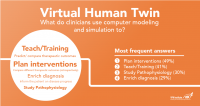The future of medicine is virtual, or better, there will be more and more virtual technologies in the future of medicine, but what do clinicians think about the Virtual Human Twin? The international non-profit organisation Virtual Physiological Human Institute (VPHi) asked this and other questions to clinicians from all over the World to take a snapshot from the point of view of who will apply such cutting-edge technologies.

The Virtual Human Twin is a digital representation of the human body that allows predictions for disease screening, diagnosis, prevention, and treatment. At the same time, it has the potential of making the development of new drugs and medical devices easier, faster, safer and cheaper, reducing the use of animals and humans during trials. Thanks to technologies like supercomputing, advanced models, and Artificial Intelligence, what sounded like science fiction, is now a reality.
The VPHi contacted more than 150 clinicians from all over the World for a survey, whose results have been recently published in the scientific journal Frontiers in Medical Technology. The medical doctors who answered the survey work mainly in cardiology, paediatrics, orthopaedics, general surgery and oncology and gave their opinion on the possible use of digital technologies in their domain. "By asking clinicians about their usage opinion and perception of digital tools, we have been surprised to see an unexpected trust level, and we could identify actual barriers and opportunities", says Raphaëlle Lesage (VPHi), the paper's first author. The answers picture the current state of applications of such a new approach in the clinics.
The clinicians expressed a high interest in the use of computational modelling and simulation, especially when it comes to planning surgeries, but also for teaching and training. However, effective uptake in clinical practice still needs to be improved by tackling unawareness and lack of access to computing or human resources. Yet, the clinicians agree that there will be a role for expertise in their team dedicated to such simulations in the next five years. "Collaborations between clinicians and modellers are happening, but the majority still believe it would be difficult to finance a position for a modeller in-house", continues Raphaëlle Lesage (VPHi).
Organisations such as VPHi and European projects such as EDITH, In Silico World,SIMCor, and SimCardioTest aim to facilitate the realisation of the opportunities given by the Virtual Twin for the benefit of patients, healthcare providers, regulatory bodies and industry, both within Europe and globally. During spring, the VPH institute will realise a new, more extended survey to verify clinicians' awareness, actual usage, and opinions. "A follow-up survey will be crucial to monitor the growth of translation of digital tools in clinical practice, capture new applications and understand the challenges which accompany such transformation”, says Claudio Capelli (University College London & Great Ormond Street Hospital for Children), co-author of the paper and creator of the first survey.
The Virtual Physiological Human Institute is a non-profit organisation born from the European Commission's homonymous initiative to support the development of methods, technologies, and procedures that allow the realisation of the Virtual Human Twin. "We are the international scientific society representing the virtual human twin community, and our main aim is to ensure that we interact with the main stakeholders in order to tackle all challenges slowing down the translation of digital tools from the computer screen to the patient" concludes Liesbet Geris, Executive Director at the VPH Institute.
Press Folder: LINK
Original Article: LINK
Brochure: LINK
Press Contacts: Davide Montesarchio, davide@vph-institute.org, +393349024929